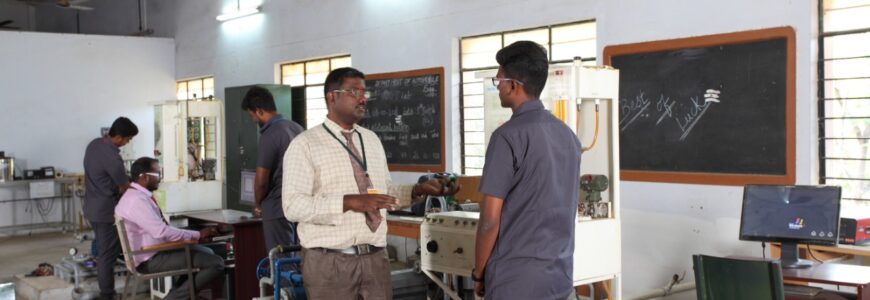
The department of Automobile Engineering started in 2006 has been active in teaching and research activities. The department has a fine blend of renowned as well as young and dynamic personalities as faculty involved in providing quality technical education. The department has 5 qualified and experienced faculties who are doctorates and postgraduates.
The department has been organizing a good number of short-term courses, workshops, National Conference and symposiums from time to time. Students releasing an half yearly magazine of our department from the year 2008 and it covers latest technologies and advancements going through in the automotive field. Our department has SAE Collegiate club from the year 2008 and is an active participant in all the SAE events.
Our students have participated in events like BAJA, SUPRA, Efficycle consequently. Students are participating in inter college events and won many prizes to prove their ability. We are maintaining good academic track record in all the years and producing University ranks consequently from 2010.
The department is well equipped with research laboratories with advanced equipments and providing services for other colleges and industries for testing and performance analysis. Highly advanced Computerized IC Engine lab is established for research activities and the lab establishment is made every year for enhancing the research activities and for the development of student’s knowledge. Students are motivated to do research projects and patents are applied in the names of the students.
We are holding a patent for 6 stroke SI engines and applied the next patent for fuel injected carburetor system. Students are well trained with advanced software like CATIA, ANSYS Fluent, Hypermesh etc and also made to participate in internship programs from leading automobile industries.
Also our students are now working in many of the reputed industries and organizations like M&M, JayamAutomotives Ltd, JP Research etc. students are energetic, enthusiastic, and eco-friendly, and are concerned about the environment and technologies.
To be a leader in higher technical education and research in the field of Automobile Engineering by providing state of art facilities and moulding youth to practice engineering profession with confidence and courage
To develop the department of Automobile Engineering into a “Centre of excellence” offering education at undergraduate, post graduate and doctoral degree level, giving opportunity for development of knowledge, skills and abilities of students and staff, bringing out their total personality, emphasizing ethical values and preparing them to meet the growing challenges of the Automotive Industry.


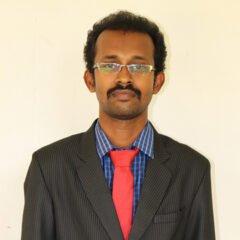
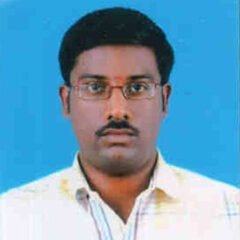
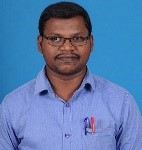
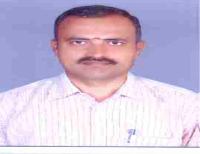
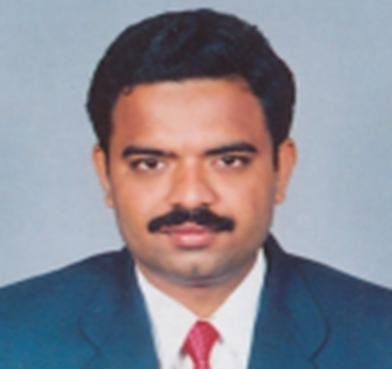
Best Academic Excellence of the students were listed in various criteria. The two of the students were full filed the criteria.
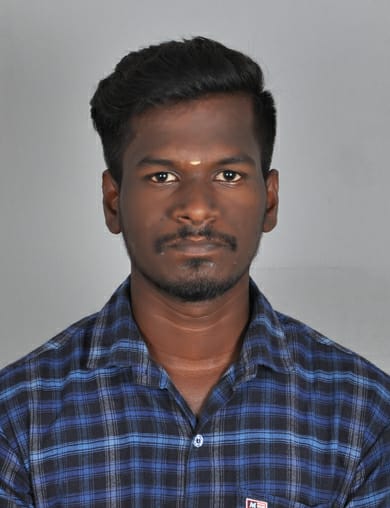
N. Jegan
IV Year
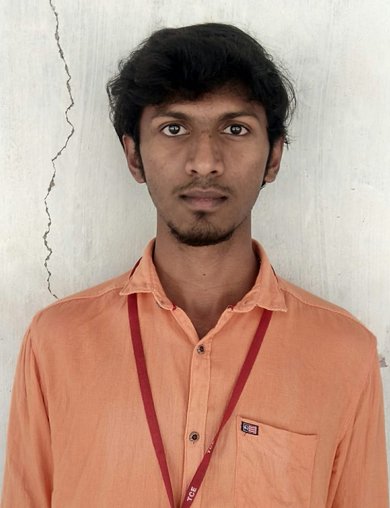
Y. Sam Shelton
III Year
Venue: Kari Motor Speedway, Coimbatore.
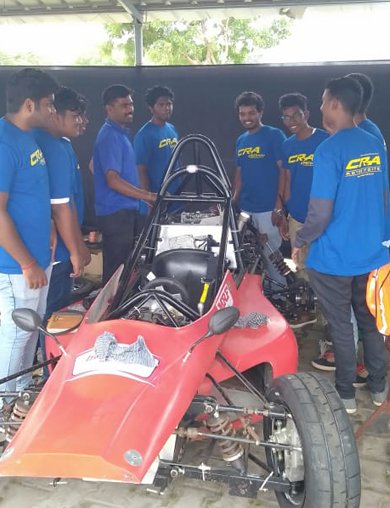
III Year Students
Mini Project Expo was conducted and the best among the project was selected and given an award.
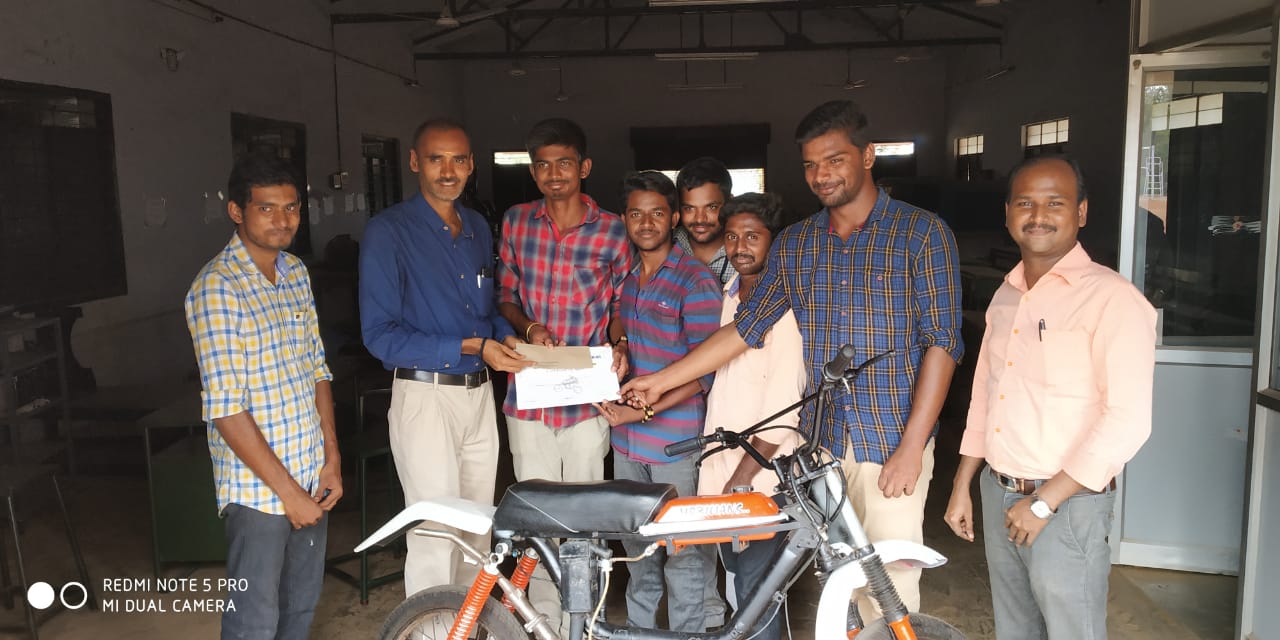
IV year Students
| SL NO | NAME OF THE LAB | ABOUT THE LAB |
|---|---|---|
| 1 | Automotive Components Lab | An automobile is the combination of different components and each one has specific work. In this lab, we can see all the major components of the automobile, and separate classes conducted dismantling and assembling of the parts. |
| 2 | CAD LAB | Design and Analysis is the major step in developing a new product. Here we design a component, test the component and we justify the reason for choosing the design and safe and reliable. Cost and production time is reduced by testing the components and parts using software. |
| 3 | Automotive Electrical and Electronics Lab | The electrical system is important in all the vehicles. The total control systems are studied known through this lab and visually all the electrical components are tested. |
| 4 | Automotive Fuels and Lubricants Lab | Every fuel and lubricating liquids have their own chemical properties. In order to use them in the vehicle, we need to select the grade of the liquid suggested by SAE. To check the grade, we test the properties in the laboratory, and the exact fuel or lubricating oil is chosen for the vehicle. |
| 5 | Computerized IC Engines lab | IC engine is the heart of all the vehicle. In this lab, we test the performance and emission characteristics of all the engines. Testing is performed in an engine that is integrated into a computer where all the results are taken directly from the computer without performing any manual calculation. Research and consultancy activities are undertaken in this lab. Alternate fuels like bio-diesel are tested in this laboratory. |
| 6 | Vehicle Maintenance and reconditioning Lab | Vehicle maintenance and live reconditioning are studied in this lab. This is a mini-workshop inside the campus where the vehicle services are taken care. The lab is provided with 3 cars, a lorry, and a bus for better understanding of the subject. |
| 7 | Electronics and Microprocessor Lab | Vehicles are now modernized and the total control of the vehicle is in an electronics system. ECU is the controller which controls all the system from starting of a vehicle, brakes, Airbags, suspension and is a controller of every single point of a vehicle. All the programs are studied and remapping can be performed by the students which will help in understanding the modern systems. |
| 8 | 2 & 3 Wheelers Lab | The components inside the two and three-wheelers are seen in life and all the dismantling and assembling of the components are studied in this laboratory. A computerized Chassis dynamometer is installed inside the lab to check the performance of a two-wheeler and consulting for other colleges and industries is undertaken in this lab. |


The department of automobile engineering is a well equipped department library is functioning in the department catering to the needs of the faculty and students for both academic and research work. It has a total of 400 books in different areas related to automobile engineering.
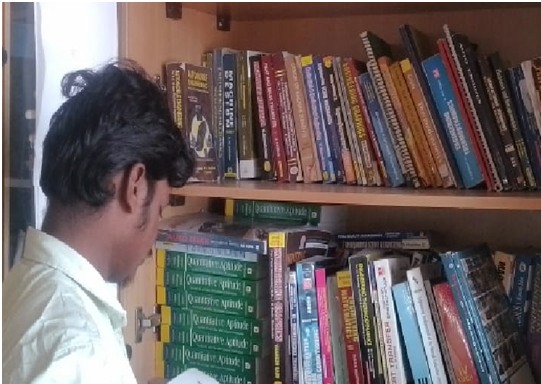
| S.NO | DATE | EVENT | TOPIC | CONDUCTED BY |
|---|---|---|---|---|
| 1 | 07/07/2018 | ABLAZE-18 | Association inaugural | M.Mohamed Arasath (alumni 2006-2010) |
| 2 | 30/01/2019 | One day seminar | Industrial 4.0 | P.Prasanthkumar(alumni 2008-2012) |
| 3 | 16/02/2019 | ABLAZE-18 | Mini bike race | V.R.palaniappan |
| 4 | 07/08/2019 | ABLAZE-19 | Association inaugural | C.Karthikeyan (alumni 2013-2017) |
| 5 | 17/02/2019 | One day seminar | E vehicle | P.Prasanthkumar (alumni 2008-2012) |
| 6 | 08/09/2021 | Online webinar | Design, Development and optimization for Entrepreneurs | D.Karthikraja, Design Engineer Head, Robert Bosh,Coimbatore |
| 7 | 23/04/2022 to 25/04/2022 | Three day workshop | Product Development Program-Electric Cycle | R.Alagarsamy, Founder and CEO, MECHNIDO, Coimbatore |
| 8 | 30.09.2022 | TECH AMALGAM 22 | Association inaugural | Mr.Arunkumar Krishnasami (alumni 2007-2011) |
| 9 | 20/04/2023 & 21/04/2023 | Two day workshop | Product Development Program-Electric Cycle | R.Alagarsamy, Founder and CEO, MECHNIDO, Coimbatore |
| S.NO | Topic | Course coordinator | Technical person | No. Of students attended | Academic year | Semester | Duration(hours) |
|---|---|---|---|---|---|---|---|
| 1 | VAE01 & Finite Element Simulation Using Ansys | Mr.G.Radhakrishnan | Mr.G.Radhakrishnan | 53 | 2018-2019 | 7 | 36 |
| 2 | VAE02 & Solidworks For Design Engineer | Mr.S.Yaknesh | Mr.S.Yaknesh | 16 | 2018-2019 | 6 | 36 |
| 3 | VAE03 & Geometric Dimensioning &Tolerancing | Mr.V.R.Palaniappan | Mr.V.R.Palaniappan | 47 | 2018-2019 | 3 | 36 |
| 4 | VAE01 & Finite Element Simulation Using Ansys | Mr.G.Radhakrishnan | Mr.G.Radhakrishnan | 29 | 2019-2020 | 3,7 | 36 |
| 5 | VAE02 & Solidworks For Design Engineer | Mr.S.Yaknesh | Mr.S.Yaknesh | 46 | 2019-2020 | 6 | 36 |
| 6 | VAE01 & Finite Element Simulation Using Ansys | Mr.G.Radhakrishnan | Mr.G.Radhakrishnan | 45 | 2018-2019 | 7 | 36 |
| 7 | VAE02 & Solidworks For Design Engineer | Mr.S.Yaknesh | Mr.S.Yaknesh | 17 | 2020-2021 | 7 | 36 |
| 8 | VAE03 & Geometric Dimensioning &Tolerancing | Mr.V.R.Palaniappan | Mr.V.R.Palaniappan | 22 | 2021-2022 | 3,5,7 | 36 |
| 9 | VAE01 & Finite Element Simulation Using Ansys | Mr.G.Radhakrishnan | Mr.G.Radhakrishnan | 19 | 2022-2023 | 3,5,7 | 36 |
| Academic year:2022-2023 |
|
|
|
||
|
|
|
|
|
|
|
| REGULATION:R2021 |
|
||||
| SEM | SUBJECT CODE | SUBJECT NAME | COURSE OUTCOME No. | COURSE OUTCOMES |
|
| I | HS3151 | Professional English - I | CO1 | Understand and produce simple sentences related to everyday situations. |
|
| CO2 | Apply appropriate transitions in the oral and written presentation. |
|
|||
| CO3 | Analyze grammatical and lexical elements in relation to sentence function and meaning. |
|
|||
| CO4 | Evaluate independent learning strategies and study skills. |
|
|||
| CO5 | Develop and create own ideas to enrich the communication skills. |
|
|||
| MA3151 | Matrices and Calculus | CO1 | Understanding the concept of limit, continuity and detrivatives of a function, Jacobian, Taylor’s series, Lagrange’s multipliers Definite and Indefinite integrals, Improper integrals, multiple integrals and System of simultaneous linear differential equations with constant coefficients |
|
|
| CO2 | Apply the rules to Solving the problems in differentiation ,finding Maxima and Minima of functions of one and two variables, calculate partial differentiation of implicit functions and applying integration techniques to evaluate the ordinary and multiple integrals and integration of irrational functions |
|
|||
| CO3 | To Acquires skills to analyse Euler’s theorem, solving integrals using various techniques of integration, Determining convergence/divergence of improper integrals differential equations by method of variation of parameter, obtaining the solution to the undetermined coefficients |
|
|||
| CO4 | Evaluation of simultaneous differential equations, Taylor’s series, maxima and minima, Ordinary and multiple integrals using polar co-ordinates |
|
|||
| CO5 | To create and combining different techniques to obtain the solutions to the real life problems involved in differentiation, partial differential equations, integration, Taylor’s series |
|
|||
| PH3151 | Engineering Physics | CO1 | To understand the Stress-strain ,Oscillatory motion forced and damped oscillations thermal conduction, convection and radiation Black body radiation Compton effect |
|
|
| CO2 | To apply the thermal insulation like heat exchangers, refrigerators, ovens and solar water heaters. |
|
|||
| CO3 | To analyze the coordination number and packing factor for SC, BCC, FCC, HCP and diamond structures |
|
|||
| CO4 | To evaluate the numerical aperture and acceptance angle |
|
|||
| CO5 | To demonstrate the torsion pendulum cantilever uniform and non-uniform bending |
|
|||
| CY3151 | Engineering Chemistry | CO1 | Applying the advanced modern scientific and engineering techniques as well as tools to assess the removal of hardness, zeolite process, applications of adsorption on pollution abatement, minimize the utilization of catalysts, formation of steel, urban problems related to energy and role of secondary & fuel batteries for our future. |
|
|
| CO2 | Analyze of the structure and function of EDTA methods, ion exchange resin, Langmuir‘s adsorption isotherm in contact theory & kinetics of surface unimolecular reactions, enzyme catalysis, - thermal analysis and cooling curves of phase rules, manufacture of metallurgical coke, flue gas analysis of exhaust gases, controlled nuclear fission & nuclear fusion reactions. |
|
|||
| CO3 | Evaluation of internal and external treatment process, adsorption of solute from solutions, catalytic poisoning and promoters in synthesis process, Pattinson process, synthetic petrol by Bergius process and controlled breeder reactor. |
|
|||
| CO4 | Describing real life application of modern scientific tools for solving problems related to desalination of brackish water, catalytic convertor, Nichrome & stainless steel manufacturing, petroleum refining, solar energy conversion and future renewable energy sectors. |
|
|||
| GE3151 | Problem Solving and Python Programming | CO1 | Examine python syntax and semantics and be fluent in the use of python flow control and functions |
|
|
| CO2 | Demonstrate proficiency in handling Threads, File and Exceptions |
|
|||
| CO3 | Analyze python program using core data structure like Lists, dictionaries and use regular Expressions. |
|
|||
| CO4 | Interpret the concepts of GUI and WEB programming as used in Python. |
|
|||
| CO5 | Implement exemplary application related to Database Programming with ORM in python. |
|
|||
| GE3171 | Problem Solving and Python Programming Laboratory | CO1 | Student should be able to understand the basic concepts scripting and the contributions of scripting language |
|
|
| CO2 | Examine the core data structures like lists, dictionaries, tuples and sets in Python to store, process and sort the data. |
|
|||
| CO3 | Identify the external modules and import specific methods form them |
|
|||
| CO4 | Demonstrate proficiency in handling Strings and File Systems. |
|
|||
| CO5 | Ability to explore python especially the object oriented concepts, and the built in objects of Python |
|
|||
| BS3171 | Physics and Chemistry Laboratory | CO1 | To understand and also remember the basic concepts of wastewater generation, collection system, wastewater quality and standards. Also demonstrate the experimental skills. |
|
|
| CO2 | To apply the basic principles for wastewater, conductometric, pH and potentiometric methods for the determination of the concentration as well as amount of the compounds present in the sample. |
|
|||
| CO3 | To analyses and interpret the data for quantitative estimation of the materials present in the given samples. |
|
|||
| CO4 | Design and Interpret field data in case of actual field problems related to wastewater & contaminations sources and also prepare the suitable models of real life applications using RO, zeolite & removal of materials by adsorbent. |
|
|||
| GE3152 | Heritage of Tamil | CO1 | To know about the drawidian languages. |
|
|
| CO2 | To understand about the classical and modern literature. |
|
|||
| CO3 | To know about the heritages of TamilNadu. To know about the modern arts and sculptures. |
|
|||
| CO4 | To know about the cultural imparts of TamilNadu. |
|
|||
| CO5 | To know about the Thinai concepts of Tamils. To know about the Trades and Victories of Cholas Kingdom. |
|
|||
| GE3172 | English laboratory | CO1 | To listen to and comprehend general as well as complex academic information |
|
|
| CO2 | To listen to and understand different points of view in a discussion |
|
|||
| CO3 | To speak fluently and accurately in formal and informal communicative contexts |
|
|||
| CO4 | To describe products and processes and explain their uses and purposes clearly and accurately |
|
|||
| CO5 | To express their opinions effectively in both formal and informal discussions |
|
|||
| REGULATION:R2021 |
|
||||
| II | HS3251 | Professional English - II | CO1 | Able to understand the listening exercises to enhance practical knowledge in communicative English |
|
| CO2 | To apply and enrich knowledge in the literacy skills. |
|
|||
| CO3 | Analyzing to communicate and write appropriately in varied formal and informal contexts. |
|
|||
| CO4 | Ability to evaluate the issues and find the rudiments of the problem individually and as a group |
|
|||
| CO5 | To design their abilities as creative thinkers, readers and writers |
|
|||
| MA3251 |
Statistics and Numerical Methods |
CO1 | Remembering the concept of Eigen values and Eigen vectors, Scalar potential, gradient, divergence, directional derivatives, curl , analytic functions Understanding the concept of Cayley-Hamilton Theorem, Angle between two surfaces, work done by force and independent of the path of the curve, Necessary and sufficient condition for analyticity and Cauchy’s integral theorem and formula and Transform of elementary, unit step and unit impulse function Laplace Transform and inverse transform of simple functions, |
|
|
| CO2 | Applying Cayley-Hamilton Theorem, transformations to diagonalize similar and symmetric matrices properties of Eigen values and Eigen vectors, canonical form for Quadratic form by orthogonal reduction, line, surface and volume integra,Solenoidal and irrottational vectors, Harmonic conjugates, bilinear transformations ,conformal mapping, and complex integration, real integral using residue theorem, transform of periodic function |
|
|||
| CO3 | Analyze Orthogonal vectors, Nature of the Quadratic form, Green, Stokes and Gauss divergence theorems, Properties of analytic functions, Taylor and Laurent series, Singularities, residue theorem and contour integration, Inverse Laplace transform, solution of linear second order differential equations with constant coefficients Shifting, initial and final value and convolution theorem |
|
|||
| CO4 | Evaluation of circuit using atrices, curve length, Area and volume of irregular shapes using line, surface and volume integral , time average power flow density using Vectors graphical image of approximation with Taylor series, application of Laplace transform in cryptography , solution of linear second order differential equations with constant coefficients using real time applications |
|
|||
| CO5 | Describing real life application of Eigen values and vectors in image processing, and cryptography vector concepts, image processing using bilinear transformations , distinguishing singularities and poles, Laplace transform and convolution theorem |
|
|||
| PH3251 | Materials Science | CO1 | Remembering Carrier transport in Semiconductors: Drift, mobility and diffusion, optical absorption and emission, charge injection and recombination, optical absorption, loss and gain Understanding Classical free electron theory, Quantum free electron theory, Electron effective mass, concept of hole, Intrinsic Semiconductors – Energy band diagram, excitonic state, Electro-optics and nonlinear optics, Quantum confinement, Quantum structures, Single electron phenomena |
|
|
| CO2 | Applying Tunneling, degenerate states, exchange interaction and ferromagnetism, quantum wells, wires and dots, Zener-Bloch oscillations, Resonant tunneling, quantum interference effects, mesoscopic structures, Single electron Transistor. Semiconductor photonic structures, carbon nanotubes: Properties and applications. |
|
|||
| CO3 | Analyze homogeneous and heterogeneous nucleation, Electron in periodic potential ,Energy bands in solids, tight binding approximation, Dia, para and ferromagnetic effects, direct and indirect band gap semiconductors, Classification of optical materials, Optical processes in semiconductors, Optical processes in quantum wells |
|
|||
| CO4 | Evaluation Crystal structures: BCC, FCC and HCP – directions and planes - linear and planar densities, Expression for electrical conductivity,Thermal conductivity, expression, Fermi- Dirac statistics, Density of energy states , paramagnetism in the conduction electrons in metals, Carrier concentration in intrinsic semiconductors – extrinsic semiconductors - Carrier concentration in N-type & P-type semiconductors – Variation of carrier concentration with temperature, 1D, 2D and 3D photonic crystal. |
|
|||
| CO5 |
Design crystal imperfections- edge and screw
dislocations – grain and twin boundaries - Burgers vector and elastic
strain energy- Slip systems, plastic deformation of materials, nucleation and
growth, quantum interference devices,GMR devices, Hall effect and devices ,Ohmic
contacts Schottky diode, Optoelectronic devices light detectors and solar cells, light emitting diode, laser diode , optical processes n organic semiconductor devices, Modulators and switching devices – plasmonics |
|
|||
| BE3251 | Basic Electrical and Electronics Engineering | CO1 | Ability to understand and explain the basic concept used in AC & DC circuits, the working, features and classification of electrical machines and electronic devices. |
|
|
| CO2 |
Ability to Apply the knowledge of electrical &
electronics for operating the circuits, machines & devices. |
|
|||
| CO3 | Ability to Analyze the characteristics parameters for ac & dc circuit, electrical machines and electron devices. |
|
|||
| CO4 | Ability to Evaluate the three pahase induction motor. |
|
|||
| CO5 | Ability to design the simple logic gates. |
|
|||
| GE3251 | Engineering Graphics | CO1 | Ability to understand the basics Projection of Points , Planes, Solids, Section of Solids , Isometric Projection and Development surfaces for simple solids. |
|
|
| CO2 |
Ability to Apply the basics Projection of Points ,
Planes, Solids, Section of Solids , Isometric Projection and Development surfaces for simple solids. |
|
|||
| CO3 |
Able to analyze the basics Projection of Points ,
Planes, Solids, Section of Solids , Isometric Projection and Development surfaces for simple solids. |
|
|||
| CO4 | Able to Explore Simple Solids generated by one modeling tool. |
|
|||
| CO5 | Ability to design simple Solids generated by one modeling tool. |
|
|||
| GE3271 | Engineering Practices Laboratory | CO1 | Ability to apply basic machining operations, welding, plumbing, sheet metal operations in order to produce the desired work output. |
|
|
| CO2 | Ability to analyse outputs of machining operations like turning, facing, milling and plumbing works, sheet metal operations, soldering and home electrical works. |
|
|||
| CO3 | Ability to conduct the experiments as individual or team by using CNC and CAD/CAM. |
|
|||
| CO4 | Ability to make an effective report based on experiments |
|
|||
| BE3271 | Basic Electrical and Electronics Engineering Laboratory | CO1 |
Ability to apply the electron knowledge to obtain the
characteristics of electron devices & circuits using systematic procedure. |
|
|
| CO2 | To analyze the experimentally the load characteristics of electrical machines and the characteristics of basic electronic devices. |
|
|||
| CO3 | To Conduct Experiments on Electron devices and circuits as individual or team by using tools. |
|
|||
| CO4 | Ability to make an effective report based on experiments. |
|
|||
| GE3272 | COMMUNICATION LABORATORY | CO1 | Speak effectively in group discussions held in a formal/semi formal contexts |
|
|
| CO2 | Discuss, analyse and present concepts and problems from various perspectives to arrive at suitable solutions |
|
|||
| CO3 | Write emails, letters and effective job applications |
|
|||
| CO4 | Write critical reports to convey data and information with clarity and precision |
|
|||
| CO5 | :Give appropriate instructions and recommendations for safe execution of tasks |
|
|||
| GE3252 | Tamils technology | CO1 | To know about the technologies during the sangam age |
|
|
| CO2 | To know about the design and construction technology during he sangam age To know about the develpoment of at Tamilnadu during the British period |
|
|||
| CO3 | To understand about the uses of the metals of Gold ,Copper,Gems during the sangam age To know the evidance described in silappathigaram |
|
|||
| CO4 | To know about the Agriculture amd irrigation technology during the sangam age |
|
|||
| CO5 | To know about th development of scientific Tamil &Tamil Computing |
|
|||
| REGULATION:R2017 |
|
||||
| III | MA3351 | Transforms and Partial Differential Equations | CO1 | Understand how to solve the given standard partial differential equations. |
|
| CO2 | Solve differential equations using Fourier Series analysis which plays a vital role in engineering applications. |
|
|||
| CO3 | Appreciate the physical significance of Fourier Series techniques in solving one and two dimensional heat flow problems and one dimensional wave equations. |
|
|||
| CO4 | understand the mathematical principles on transforms and partial differential equations would provide them the ability to formulate and solve some of the physical problems of engineering. |
|
|||
| CO5 | Use the effective mathematical tools for the solutions of partial differential equations by using Z transform techniques for discrete time systems. |
|
|||
| ME3393 | Manufacturing Processes | CO1 | Explain the principle of different metal casting processes. |
|
|
| CO2 | Describe the various metal joining processes. |
|
|||
| CO3 | Illustrate the different bulk deformation processes. |
|
|||
| CO4 | Apply the various sheet metal forming process. |
|
|||
| CO5 | Apply suitable molding technique for manufacturing of plastics components. |
|
|||
| AU3301 | Thermodynamics and Heat Transfer | CO1 | Demonstrate the understanding of the nature of the thermodynamic processes for pure substances of ideal gases |
|
|
| CO2 | Interpret First Law of Thermodynamics and its application to systems and control volumes |
|
|||
| CO3 | Solve any flow specific problem in an engineering approach based on basic concepts and logic sequences. |
|
|||
| CO4 | Compare and contrast between various types of refrigeration cycles |
|
|||
| CO5 | Understand the basics and modes of heat transfer |
|
|||
| ME3351 | Engineering Mechanics | CO1 | Illustrate the vector and scalar representation of forces and moments |
|
|
| CO2 | Analyse the rigid body in equilibrium |
|
|||
| CO3 | Evaluate the properties of distributed forces |
|
|||
| CO4 | Determine the friction and the effects by the laws of friction |
|
|||
| CO5 | Calculate dynamic forces exerted in rigid body |
|
|||
| AU3302 | Automotive Hydraulics and Machinery | CO1 | Apply the basic concepts of fluids statics and dynamics |
|
|
| CO2 | Summarize the concepts of flow governing equations |
|
|||
| CO3 | Generate solutions to complex pipe flow problems |
|
|||
| CO4 | Interpret the results of dimensional analysis |
|
|||
| CO5 | Understand the applications of fluid machinery in automotives |
|
|||
| AU3303 | Automotive Engines | CO1 | Identify various components of SI and CI engines |
|
|
| CO2 | Explain the functions of IC engine sub‐systems like Ignition, cooling and lubrication |
|
|||
| CO3 | Understand the actual engine working principle and its thermochemistry of fuel‐air mixtures |
|
|||
| CO4 | Describe the basic knowledge on SI and CI engine combustion and its related parameters |
|
|||
| CO5 | Apply their knowledge in analyzing the engine performance and pollution characteristics. |
|
|||
| AU3311 | Mechanical Sciences Laboratory | CO1 | Conduct experiments to understand the physical characterization of materials. |
|
|
| CO2 | Identify the various experimental testing methods for of mechanical properties of materials. |
|
|||
| CO3 | Evaluate the basics of fluid flow characteristics. |
|
|||
| CO4 | Measure experimentally the Performance characteristics of pumps. |
|
|||
| CO5 | Determine experimentally the Performance characteristics of turbines. |
|
|||
| ME3382 | Manufacturing Technology Laboratory | CO1 | Demonstrate the safety precautions exercised in the mechanical workshop and join two metals using GMAW. |
|
|
| CO2 | The students able to make the work piece as per given shape and size using machining process such as rolling, drawing, turning, shaping, drilling and milling. |
|
|||
| CO3 | The students become make the gears using gear making machines and analyze the defects in the cast and machined components |
|
|||
| GE3361 | Professional Development | CO1 | Use MS Word to create quality documents, by structuring and organizing content for their day to day technical and academic requirements |
|
|
| CO2 | Use MS EXCEL to perform data operations and analytics, record, retrieve data as per requirements and visualize data for ease of understanding |
|
|||
| CO3 | Use MS PowerPoint to create high quality academic presentations by including common tables, charts, graphs, interlinking other elements, and using media objects. |
|
|||
| REGULATION:R2017 |
|
||||
| IV | AU3401 | Fuels and Lubricants | CO1 | Identify the fuels and lubricants for automotive applications |
|
| CO2 | Understand the properties of fuels and lubricants and its testing equipment |
|
|||
| CO3 | Evaluate the properties of fuels and lubricants |
|
|||
| CO4 | Select suitable fuel and lubricant testing equipment |
|
|||
| CO5 | Analyse the behaviour of fuels and lubricants |
|
|||
| AU3402 | Automotive Chassis | CO1 | Identify the different types of frame and chassis used in Automotive. |
|
|
| CO2 | Classify the different types of drivelines and drives used in Automotive. |
|
|||
| CO3 | Acquire knowledge about different types of front axle and rear axles used in motor vehicles. |
|
|||
| CO4 | Examine the working principle of conventional and independent suspension systems. |
|
|||
| CO5 | Apply knowledge on working principles of brake and its subsystems. |
|
|||
| AU3403 | Vehicle Body Engineering | CO1 | Understand the different aspects of car body |
|
|
| CO2 | Differentiate the bus and commercial vehicle bodies. |
|
|||
| CO3 | Describe the role of various aerodynamic forces and moments, measuring instruments in vehicle body design. |
|
|||
| CO4 | Identify the materials used in body building, |
|
|||
| CO5 | Select hand tools for body repairs and maintenance. |
|
|||
| ML3391 | Mechanics of Solids | CO1 | Apply the principle concepts behind stress, strain and deformation of solids for various engineering applications. |
|
|
| CO2 | Analyze the transverse loading on beams and stresses in beam for various engineering applications. |
|
|||
| CO3 | Solve problems based on the torsion principles involved in shafts and springs for various engineering applications. |
|
|||
| CO4 | nterpret the results of the deflection of beams. |
|
|||
| CO5 | Analyze the thin and thick shells and principal stresses in beam for various engineering applications |
|
|||
| AU3404 | Automotive Transmission | CO1 | Understand the construction and working of various types of clutches |
|
|
| CO2 | Determine the gear ratio for different vehicle applications |
|
|||
| CO3 | Describe the types and principle of hydrodynamic transmission |
|
|||
| CO4 | Compare Hydrostatic and hydrodynamics drives |
|
|||
| CO5 | Identify the differences among various automatic transmissions. |
|
|||
| GE3451 | Environmental Sciences and Sustainability | CO1 | Understand the nature and its impacts on human life. |
|
|
| CO2 | The students have the knowledge and awareness of Environmental Pollution. |
|
|||
| CO3 | Understanding of the energy sources and scientific concepts/principles behind them |
|
|||
| CO4 | Understand the concepts of the Sustainability and Management |
|
|||
| CO5 | Understand the Sustainability Practices and socio economical changes |
|
|||
| AU3411 | Vehicle Components Laboratory | CO1 | Dismantle and Assemble the automobile chassis and Engine components |
|
|
| CO2 | Identify & differentiate components of SI & CI engines |
|
|||
| CO3 | Understand working of braking, steering, clutch, transmission, Suspension systems. |
|
|||
| CO4 | Develop skills in Dismantling and assembling of chassis components. |
|
|||
| CO5 | Correct minor repairs and trouble shoots the breakdowns |
|
|||
| AU3412 | Fuels and Lubricants Laboratory | CO1 | Develop skills and understand various testing methods adopted to assess quality of fuels and lubricants like Viscosity |
|
|
| CO2 | Develop skills and understand various testing methods adopted to assess quality of fuels and lubricants like Importance of flash, fire point |
|
|||
| CO3 | Develop skills and understand various testing methods adopted to assess quality of fuels and lubricants like Cloud and pour point |
|
|||
| CO4 | Develop skills and understand various testing methods adopted to assess quality of fuels and lubricants like Calorific value |
|
|||
| CO5 | Develop skills and understand various testing methods adopted to assess quality of fuels and lubricants like Density |
|
|||
| REGULATION:R2017 |
|
||||
| V | ME 8651 | Design of Transmission Systems | CO1 | Ability To Define, Understand The Flexible Elements |
|
| CO2 | Ability To Apply Different Spur And Helical Gears Manufacturing Methods For Automotive Purpose |
|
|||
| CO3 | Ability To Analyse The Various Methods To Attain The Desired Gear From The Bevel And Worm Gears |
|
|||
| CO4 | Ability To Design Type Of Gear Box For The Transmission Systems |
|
|||
| CO5 | Ability To Apply The Cmas, Clutches And Brakes In Automotive Systems |
|
|||
| OCE551 | Air Pollution and Control Engineeing | CO1 | Classify and identify the sources of air pollutants and predict the effects of air pollutant on human health and environment. |
|
|
| CO2 | Apply and relate the significance of various air pollution dispersion models. |
|
|||
| CO3 | Analyze the air quality and relate with air pollution regulation |
|
|||
| CO4 | Design various air pollution control equipment and evaluate its use |
|
|||
| AT8501 | Automotive Transmission | CO1 | Understand construction of different section of chassis frame |
|
|
| CO2 | Find out driving thrust for different vehicle condition |
|
|||
| CO3 | Analyze the different type of rear axle |
|
|||
| CO4 | Find out the requirement of suspension system |
|
|||
| CO5 | Calculate braking condition for different condition |
|
|||
| AT8502 | Automotive Electrical and Electronics Systems | CO1 | Define the glossary related to vehicle electrical and electronic system |
|
|
| CO2 | Explain the need for starter batteries, starter motor and alternator in the vehicle. |
|
|||
| CO3 | Differentiate the conventional and modern vehicle architecture and the data transfer among the different electronic control unit using different communication protocols |
|
|||
| CO4 | List common types of sensor and actuators used in vehicles. |
|
|||
| CO5 | nderstand networking in vehicles. |
|
|||
| AT8503 | Vehicle Design Data Characteristics | CO1 | Analyze the different vehicle characteristics |
|
|
| CO2 | Knowledge in vehicle electrical and electronics components for engine operation. |
|
|||
| CO3 | Enhancing the knowledge of sensor and microprocessor applications in vehicle control systems. |
|
|||
| CO4 | Gaining information’s on modern safety system in vehicle braking. |
|
|||
| CO5 | Analyze the different vehicle safety system |
|
|||
| AT8504 | Automotive Fuels and Lubricants | CO1 | Describe about gasoline and air mixtures with requirements and formation of carburetor, Choke and carburetor systems for emission control. |
|
|
| CO2 | Apply the knowledge of instruction set to develop Fuel Injection Systems, Timing Systems, Energy requirement and Spark plug operation. |
|
|||
| CO3 | Discuss about the Stages of combustion and Heat release correlations. |
|
|||
| CO4 | Brief about Liquid fuel Requirements and utilization techniques of Blends, Neat form and Reformed Fuels. |
|
|||
| CO5 | Measuring the emission techniques for SI Engines. |
|
|||
| HS 8581 | Professional Communication | CO1 | Be able to manage and apply grammar appropriately |
|
|
| CO2 | Be able to define and analyze the process of communication |
|
|||
| CO3 | Be able to evaluate, organize and deliver an informative and persuasive presentation |
|
|||
| CO4 | Create and deliver effective presentation before the audience and the interview panel |
|
|||
| AT8511 | Automotive Electrical and Electronics Laboratory | CO1 | Understand the working principle of Electrical circuits in automobile. |
|
|
| CO2 | Evaluate the working principle of Battery, and starter motor. |
|
|||
| CO3 | Describe the working principle of auxiliary systems used in automobiles. |
|
|||
| CO4 | Explain the use of sensors in an automobile. |
|
|||
| CO5 | Develop a programing knowledge on Microprocessor |
|
|||
| AT8512 | Automotive Fuels and Lubricants Laboratory | CO1 | Describe about gasoline and air mixtures with requirements and formation of carburetor, Choke and carburetor systems for emission control. |
|
|
| CO2 | Apply the knowledge of instruction set to develop Fuel Injection Systems, Timing Systems, Energy requirement and Spark plug operation. |
|
|||
| CO3 | Discuss about the Stages of combustion and Heat release correlations. |
|
|||
| CO4 | Brief about Liquid fuel Requirements and utilization techniques of Blends, Neat form and Reformed Fuels. |
|
|||
| CO5 | Discuss about grease and mechanical penetration in grease |
|
|||
| REGULATION:R2017 |
|
||||
| VI | GE 8077 | Total Quality Management | CO1 | Upon completion of this course, the students can able to understand about the basic concepts of TQM and Discuss various dimensions of product and service quality |
|
| CO2 | Ability to state the TQM principles for quality improvement in organization |
|
|||
| CO3 | Ability to combine various TQM tools and techniques used in Manufacturing and Service sectors |
|
|||
| CO4 | Ability to evaluate techniques for effective utilization of operational resources and use QFD tool to design and develop a new product as per customer requirements |
|
|||
| CO5 | Explain various ISO Standards and Quality systems practiced in various sector |
|
|||
| AT8601 | Automotive Engine Components Design | CO1 | Know how to design the different types of gears like spur gear, helical gear, bevel gear worm gear etc. |
|
|
| CO2 | Design and analyze automobile components to meet performance requirements by selecting a concept to pursue, iterating to the final design. |
|
|||
| CO3 | Determine when a component will fail statically given loading conditions. |
|
|||
| CO4 | Apply the concept of limits, fits and tolerance during the design of engine and chassis components |
|
|||
| CO5 | Understood the how to design belt drives, springs, keys, couplings and flywheels. |
|
|||
| AT8602 | Automotive Chassis Components Design | CO1 | Understand construction of different section of chassis frame. |
|
|
| CO2 | Find out driving thrust for different vehicle condition. |
|
|||
| CO3 | Analyze the different type of rear axle |
|
|||
| CO4 | Find out the requirement of suspension system. |
|
|||
| CO5 | Calculate braking condition for different condition. |
|
|||
| AT8603 | Two and Three Wheelers | CO1 | Diagnose the simple problems on fuel, ignition, cooling, lubrication and electrical systems |
|
|
| CO2 | Analyze engine performance characteristics |
|
|||
| CO3 | Calculate braking condition for different condition. |
|
|||
| CO4 | Find out the requirement of suspension system. |
|
|||
| CO5 | Analyze the different type of rear axle. |
|
|||
| AT8604 | Vehicle Dynamics | CO1 | Write mathematical models of vehicle road dynamics. |
|
|
| CO2 | Recognize the effect of the tyre forces and characteristics on the vehicle dynamics |
|
|||
| CO3 | Calculate aerodynamic effects for different types of vehicle. |
|
|||
| CO4 | Know the sources of vehicle vibration and minimizing it by proper design. |
|
|||
| CO5 | Understand the rolling resistance, drag, noise and vehicle vibration. |
|
|||
| AT8611 | Computer Aided Engine and Chassis Design Laboratory | CO1 | Design and analyze automobile components to meet performance requirements by selecting a concept to pursue, iterating to the final design. |
|
|
| CO2 | Design and analyze automobile components to meet performance requirements by selecting a concept to pursue, iterating to the final design. |
|
|||
| CO3 | Know how to design the different types of gears like spur gear, helical gear, bevel gear worm gear etc. |
|
|||
| CO4 | Understood the how to design belt drives, springs, keys, couplings and flywheels. |
|
|||
| CO5 | Design and analyze simple machine components gears, shafts and bearings. |
|
|||
| AT8612 | Two and Three Wheelers Laboratory | CO1 | Analyze engine performance characteristics. |
|
|
| CO2 | Calculate braking condition for different condition. |
|
|||
| CO3 | Find out the requirement of suspension system |
|
|||
| CO4 | Analyze the different type of rear axle. |
|
|||
| CO5 | Calculate steering condition for different condition |
|
|||
| REGULATION:R2017 |
|
||||
| VII | AT8701 | Engine and Vehicle Management System | CO1 | Understand various engine parameters and its control |
|
| CO2 | Understand the role of various sensor |
|
|||
| CO3 | Understand the control aspects in SI engine system |
|
|||
| CO4 | Understand the control aspects in CI engine system |
|
|||
| CO5 | Familiarise the working of modern vehicle management systems |
|
|||
| ME8692 | Finite Element Analysis | CO1 | Summarize the basics of finite element formulation. |
|
|
| CO2 | Apply finite element formulations to solve one dimensional Problems. |
|
|||
| CO3 | Apply finite element formulations to solve two dimensional Problems. |
|
|||
| CO4 | Apply finite element method to solve heat transfer and fluid mechanics problems. |
|
|||
| CO5 | Apply finite element method to solve problems on dynamic analysis. |
|
|||
| AT8702 | Vehicle Maintenance | CO1 | Analyze the different vehicle characteristics | ||
| CO2 | Knowledge in vehicle electrical and electronics components for engine operation. |
|
|||
| CO3 | Enhancing the knowledge of sensor and microprocessor applications in vehicle control systems. |
|
|||
| CO4 | Gaining information’s on modern safety system in vehicle braking. | ||||
| CO5 | Analyze the different vehicle safety system |
|
|||
| GE8071 | Disaster Management | CO1 | Differentiate the types of disasters, causes and their impact on environment and society |
|
|
| CO2 | Assess vulnerability and various methods of risk reduction measures as well as mitigation. |
|
|||
| CO3 | Draw the hazard and vulnerability profile of India, Scenarious in the Indian context, Disaster damage assessment and management. |
|
|||
| OCE751 | Environmental And Social Impact Assessment | CO1 | carry out scoping and screening of developmental projects for environmental and social assessments |
|
|
| CO2 | explain different methodologies for environmental impact prediction and assessment |
|
|||
| CO3 | plan environmental impact assessments and environmental management plans |
|
|||
| CO4 | evaluate environmental impact assessment reports |
|
|||
| GE8074 | Human Rights | CO1 | Understand the historical growth of the idea of human rights |
|
|
| CO2 | Demonstrate an awareness of the international context of human rights |
|
|||
| CO3 | Demonstrate an awareness of the position of human rights in the UK prior to 1998 |
|
|||
| CO4 | Understand the importance of the Human Rights Act 1998 |
|
|||
| AT8712 | Vehicle Maintenance Laboratory | CO1 | Know how to identify the faults. |
|
|
| CO2 | Know how to identify knowledge. |
|
|||
| CO3 | Know how to identify on maintenance. |
|
|||
| CO4 | Analyze the Fault diagnosis. |
|
|||
| CO5 | Calibration of different equipment. |
|
|||
| AT8711 | Engine Performance and Emission Testing | CO1 | Know how to control the emission. |
|
|
| CO2 | Understood the different equipment. |
|
|||
| CO3 | Know how to conduct performance test. |
|
|||
| CO4 | Analyze the indicated power. |
|
|||
| CO5 | Determine data acquisition system. |
|
|||
| REGULATION:R2017 |
|
||||
| VIII | AT8801 | Vehicle Body Engineering | CO1 | Understand the different aspects of car body |
|
| CO2 | Differentiate the bus and commercial vehicle bodies. |
|
|||
| CO3 | Describe the role of various aerodynamic forces and moments, measuring instruments in vehicle body design. |
|
|||
| CO4 | Identify the materials used in body building, |
|
|||
| CO5 | Select hand tools for body repairs and maintenance. |
|
|||
| AT8008 | Transport Management | CO1 | Know about different aspects related to transport system and management. |
|
|
| CO2 | Features of scheduling, fixing the fares |
|
|||
| CO3 | Know about the motor vehicle act and maintenance aspects of transport. |
|
|||
| GE8076 | Professional Ethics In Engineering | CO1 | Identify the importance of democratic, secular and scientific values in harmonious functioning of social life |
|
|
| CO2 | Practice democratic and scientific values in both their personal and professional life. |
|
|||
| CO3 | Find rational solutions to social problems. |
|
|||
| CO4 | Behave in an ethical manner in society |
|
|||
| CO5 | Practice critical thinking and the pursuit of truth. |
|
|||
| AT 8811 | Project Work | CO1 | Ability to find the need/purpose of selection of particular task |
|
|
| CO2 | Ability to apply basic mechanical concepts, simple mechanisms, various techniques, procedures, theorem, formulae |
|
|||
| CO3 | Interpret the findings with appropriate technological / research citation |
|
|||
| CO4 | Perform multi-disciplinary task as an individual and / or team member to manage the project/task |
|
|||
| CO5 | Justify ethical principals in engineering practises |
|
|||